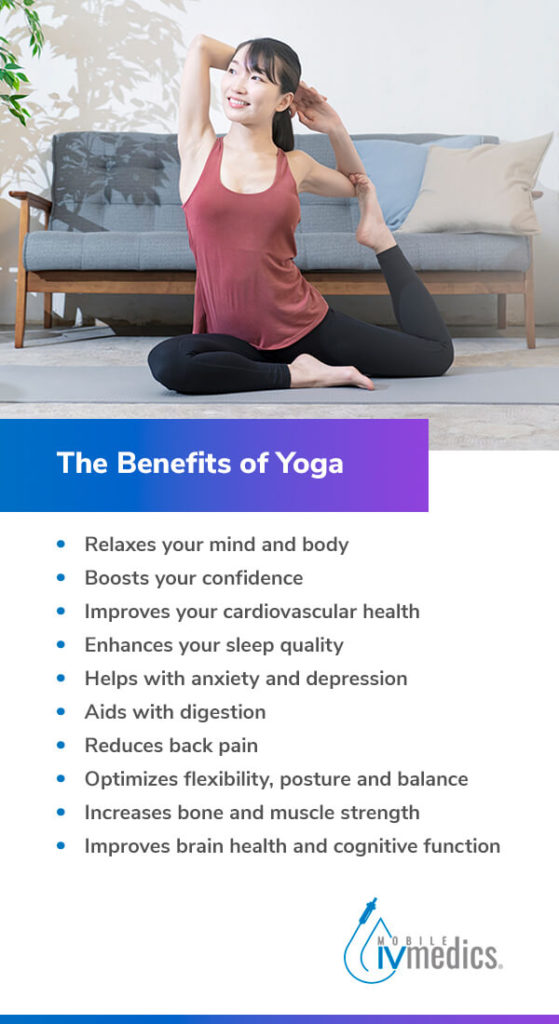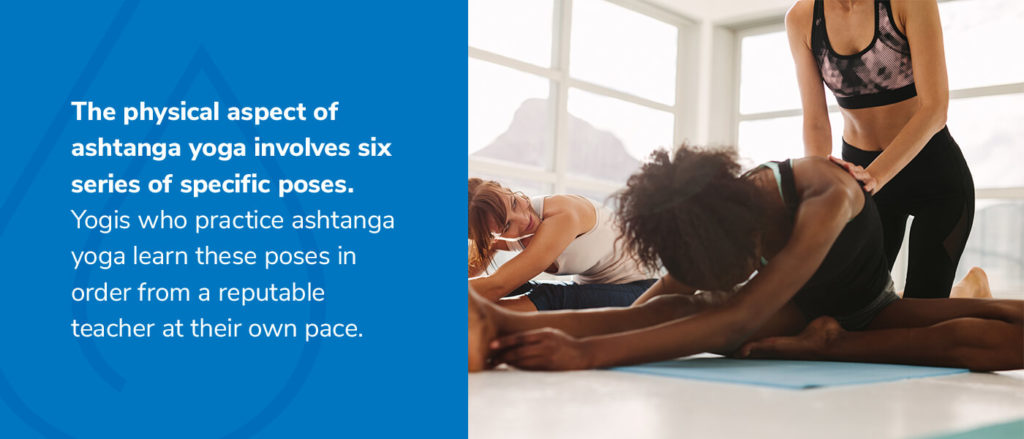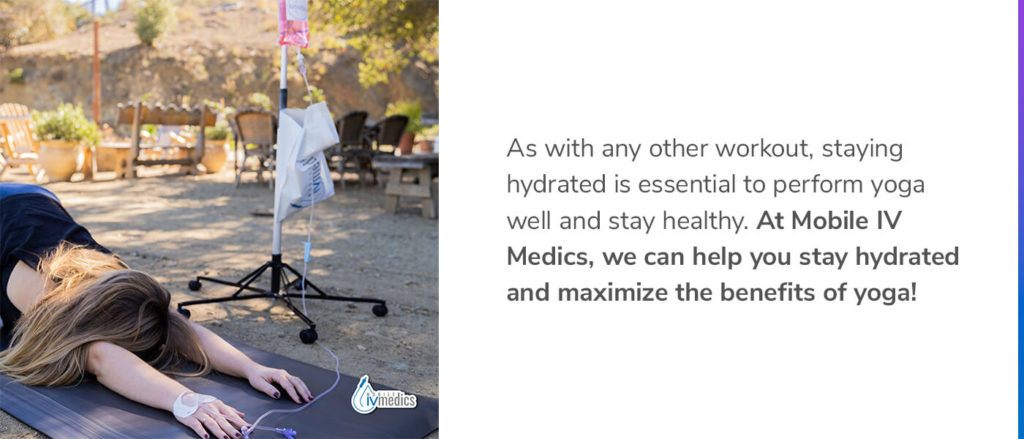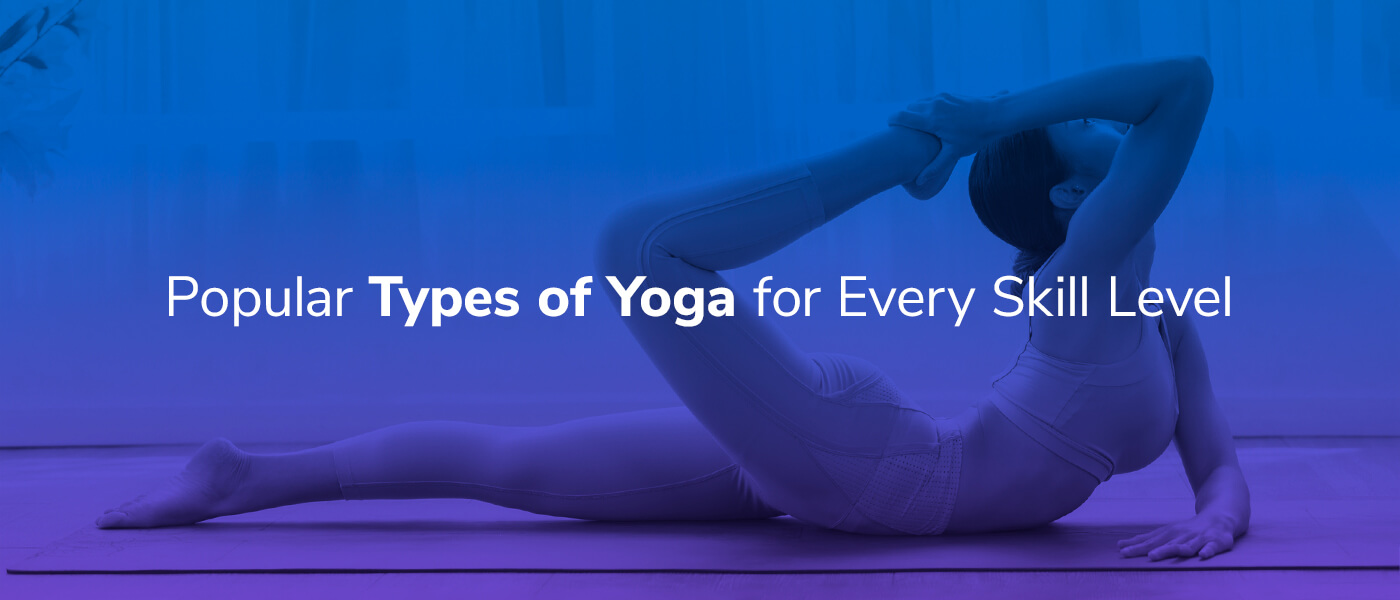If yoga seems like an exclusive form of exercise, we’re happy to inform you otherwise! The core principles of yoga are compassion and non-judgment toward yourself and others. When the true spirit of yoga is practiced and embraced, yoga is a beneficial form of exercise that anyone can practice. Whether you seek yoga for beginners or yoga for experts, you can find helpful info on the popularity, benefits and types of yoga below!
Table of Contents:
- Understanding the Growing Popularity of Yoga
- The Benefits of Yoga
- Popular Types of Yoga
- Choosing Mobile IV Medics
- Contact Mobile IV Medics Today
Understanding the Growing Popularity of Yoga
Approximately one in seven adults practice yoga in the United States, totaling over 36 million people! Studies estimate around 10 million U.S. adults actively practiced yoga in 2002. So the popularity of yoga has increased threefold over the past 20 years. Although yoga’s popularity is a recent phenomenon in the U.S., it is an ancient holistic practice rooted in Eastern wisdom. Ancient Indian texts record yoga practices as far back as 5,000 years ago.
So what is the reason for this growing interest in yoga in Western parts of the world? Many possible explanations exist. Its philosophy of non-judgment and compassion for ourselves and others is attractive to many. The most common reasons individuals start yoga is to relax and prevent injury and disease. They continue practicing yoga for the physical and spiritual benefits.
Other reasons for the rise of yoga in the United States include:
- The accessibility of yoga for all ages, body types and skill levels: Yoga is an inclusive exercise. You can find yoga exercises tailored to various health benefits, such as yoga for weight loss or yoga for meditation. Yoga poses are also customizable to your body, flexibility level and daily mood. Whether you are young or old, a beginner or an expert, you can experience the benefits of yoga.
- The proven benefits of yoga: Many studies show the many benefits yoga can provide to your mental and physical well-being. These benefits involve your physical health, mental wellness and even your motivation for living a healthy life.
- The cost-savings of yoga compared with other exercise methods: Anyone can start yoga with minimal equipment. Ideally, you will have an exercise mat and comfortable clothing for stretching when performing yoga poses. There is also wiggle room for what counts as a yoga mat if you can’t fit one in your budget right away!

The Benefits of Yoga
Studies have shown yoga to provide many benefits to regular practitioners. Here are ten of those benefits:
- Relaxes your mind and body: Although it is well-known that yoga reduces stress, the way it does so is less known. Some studies suggest yoga reduces stress by helping practitioners appraise stress through a lens of non-judgment. Other studies point toward inhibited production of cortisol — the stress hormone — in the posterior hypothalamus.
- Boosts your confidence: Yoga can boost confidence and self-esteem among those who practice it due to its self-affirming philosophy.
- Improves your cardiovascular health: On a practical level, yoga offers a safe way to exercise for patients with heart conditions. It can also lower heart rate and blood pressure through controlled breathing. With lowered heart rate and blood pressure, your heart works more efficiently.
- Enhances your sleep quality: Meditative yoga improves sleep quality by reducing sleep disturbances and optimizing sleep structure. Some ways yoga does so include increased relaxation, reduced stress and improved regulation of your body’s internal processes, i.e., homeostasis.
- Helps with anxiety and depression: Various studies show the positive impact of yoga on anxiety and depression. As such, yoga can serve as a supplemental treatment for such mental illnesses. Research is unclear on how yoga can help anxiety and depression.
- Aids with digestion: Many digestive issues are comorbid with stress, depression and anxiety. The calming mechanisms of yoga have improved many people’s digestive issues.
- Reduces back pain: Yoga can benefit individuals with chronic back pain, as recent studies show it can ease moderate to severe lower back pain.
- Optimizes flexibility, posture and balance: The direct benefits of yoga include improved flexibility, posture and balance. Yoga positions stretch your muscles and joints, strengthen muscles that support balance and promote good posture. Research supports these findings, as well.
- Increases bone and muscle strength: Yoga can improve your bone and muscle health. For your bones, research shows yoga can increase your bone density and even reverse osteoporotic bone loss. Yoga can also increase muscular strength among practitioners of any age group.
- Improves brain health and cognitive function: Studies show yoga improves neural connectivity in your hippocampus and prefrontal cortex. These areas of your brain are responsible for memory, attentiveness and learning abilities. They also experience significant decline as we age. Thus, yoga can mitigate some of the cognitive effects of aging.
Popular Types of Yoga
To understand the different types of yoga, outlining the eight limbs of yoga is beneficial. These eight limbs summarize the ultimate aims of yogic practice. They include:
- Ethical life choices or Yamas: These ethical life choices consist of several governing categories. Roughly translated, these categories are nonviolence and compassion, truthfulness, “non-stealing,” moderation and “non-greed.”
- Personal observances or Niyamas: Personal observances involve self-discipline and spiritual purpose. The governing categories of this limb include contentment, introspection, devotion to a higher purpose, disciplined use of energy and purity of body and mind.
- Posture practices or Asanas: Asanas refer to any physical yoga pose that promotes mindful, internal practices. The Western tradition of yoga focuses predominantly on this limb.
- Breathing practices or Pranayama: Pranayama is the other yogic limb that Western practice focuses on. This limb involves breathing practices that connect your mind with your body. Pranayama examples include balancing breath, breath retention, cleansing breath, energizing breath, natural breath and victorious breath.
- Sense withdrawal or Pratyahara: This yogic limb involves practices that draw your awareness inward, freed from sensory distraction. These practices support the final three limbs of yoga.
- Concentration or Dharana: Dharana are practices that help practitioners, or yogis, purify their thoughts through deep, internal concentration on a single point of focus. These practices reduce mental chatter and help practitioners transcend regular thinking patterns.
- Meditation or Dhyana: Meditation in yoga involves an effortless state of deep concentration that goes beyond a single focus point. Rather than an isolated practice, yogic meditation filters everything a practitioner experiences.
- Absorption or Samadhi: This final yogic limb is the highest state of meditative consciousness one can achieve. It is a state of ecstasy that follows a profound connection with a greater whole, also known as bliss or enlightenment.
Here are a few popular types of yoga that incorporate some or all eight limbs.
Hatha Yoga
The word “ha-tha” blends the Sanskrit words for sun and moon. This blending implies the union of opposing forces. In yoga, hatha is an umbrella term encompassing any yoga style with physical poses, breathing exercises and meditation. Hence, all physically-based yoga is hatha yoga. Other forms of yoga, like kriya, karma or raja, are non-physical. These types of yoga focus on meditation, breathwork and selfless service.
Hatha yoga’s usage in Western contexts generally applies to a gentle yoga practice. These practices involve holding gentle poses for around 30-seconds to one minute. Unlike other yoga styles, hatha yoga does not include continuous flow between movements.
Since hatha yoga is slower-paced and encompasses a significant breadth of exercises, it is adaptable to any skill level. As such, many practitioners and teachers consider hatha beginner-friendly yoga. Yoga teachers and practitioners can tailor and adapt hatha exercises to any body type, fitness status or flexibility level.

Ashtanga Yoga
Ashtanga is a Sanskrit word meaning “eight limbs.” This yoga style incorporates all eight yoga limbs, making it more suited to experienced yogis. Ashtanga yoga has ancient roots, but today’s style began in the first half of the 20th century.
The physical aspect of ashtanga yoga involves six series of specific poses. Yogis who practice ashtanga yoga learn these poses in order from a reputable teacher at their own pace. Once the student learns one pose, the teacher shows them the next one until they master all six movements. Each posture flows into the next one through deliberate breathing patterns and movements.
The ultimate goal of ashtanga yoga is to master all eight limbs of yoga. On a physical level, the purpose of ashtanga movements is to:
- Cultivate strength and grace.
- Regulate breathing to achieve homeostasis — the stability of internal conditions.
A recent study on ashtanga yoga points to benefits for improving various mental and physical health disorders. The specific disorders the study mentions are depression, cardiovascular and metabolic diseases and breast cancer. It also suggests benefits for stress management, pregnancy and the vascular and immune function of older adults.
Vinyasa Yoga
Perhaps today’s most popular form of yoga, vinyasa yoga, was adapted from ashtanga yoga in the 1980s. Vinyasa was always a part of ashtanga yoga, as it simply involves continuous flow through different yoga poses. The distinguishing factor between vinyasa and ashtanga yoga is the absence of specific series. In this way, vinyasa is more free-flowing than ashtanga yoga. Vinyasa yoga is ideal for individuals looking for the next challenge after beginner yoga but aren’t ready to leap ashtanga yoga.
The English translation of vinyasa is “to place in a special way.” When applied to yoga, this refers to the deliberate movements and poses that you mediate through your breath. Vinyasa can involve a mix of basic poses and more advanced poses. Advanced versions of vinyasa yoga are highly athletic and sometimes called power yoga.
Iyengar Yoga
Iyengar yoga is a unique style of yoga. Its founder and namesake, B.K.S. Iyengar, developed this style in the 1960s. Its purpose is to bring about the alignment of our bodies with our physical, emotional and mental sensations.
The unique aspect of iyengar yoga is its use of props. While not essential for all iyengar exercises, this yoga style utilizes props. Standard props include chairs, blankets, belts, straps, blocks or whatever the practitioner needs to support their poses. The added support intends to add complexity and depth to yoga. Still, a secondary benefit is that the props make the poses easier to do.
Besides props, iyengar yoga also prioritizes precision, timing and sequencing with the movements. For this reason, this style of yoga is well-suited for both beginners and experienced yogis. The props help individuals who want to go slow, while the emphasis on precision and timing offers a challenge to expert yoga practitioners.
Hot Yoga
Hot yoga is a variation on bikram yoga and is pretty much what you would expect it to be — yoga with some heat. Hot yoga occurs in a heated, sauna-like room. Bikram yoga involves 26 postures in rooms heated to 105 degrees Fahrenheit with 40% humidity. Hot yoga is less particular.
The simplest description of hot yoga is any yoga performed in a room heated above normal room temperature. Still, most hot yoga classes have specific temperatures they set their rooms to. So the main difference between bikram yoga and hot yoga is the number and type of postures performed. Hot yoga is recommended for yogis of any skill level who are free from health conditions that may cause complications. Speak to your doctor before performing hot yoga if you:
- Have heart disease.
- Are pregnant.
- Experience heat intolerance.
- Have problems with dehydration.
- Have a history of heat-related illnesses, such as heatstroke.
These yoga styles do not encompass the multitudes in today’s yoga universe! These styles include specialized techniques like prenatal yoga, therapeutic approaches such as goat yoga and acrobatic ones like aerial yoga. You should have an easy time finding a yoga flavor that suits your fancy!

Choosing Mobile IV Medics
As with any other workout, staying hydrated is essential to perform yoga well and stay healthy. Moreover, while yoga has excellent potential to keep you healthy, you can always find ways to supplement its benefits with other healthy choices. At Mobile IV Medics, we can help you stay hydrated and maximize the benefits of yoga!
Our IV clinic is 100% mobile, so we bring drip therapy to you! Here are a few IV packages we offer that can supplement your yoga routine:
- IV Hydration package: Our hydration drip uses a saline solution, which is a mix of electrolytes, sodium chloride and water. IV saline drips restore your body’s lost fluids quicker than drinking water or other beverages. You can also add various vitamins, minerals, amino acids or antioxidants for supplemental benefits.
- Energy & Focus IV Drip package: This IV package boosts energy and focus through a powerful influx of saline, vitamins B and B12, taurine and vitamin C. Some benefits include improved sleep, healthier skin, enhanced productivity, reduced stress levels and increased motivation
- Weight Loss IV Drip package: Our weight loss drip contains several vitamins and amino acids, along with saline and taurine. The vitamins include vitamin B, B12 and C, while the amino acids include Methionine Inositol Choline (MIC). This IV drip helps with weight loss by boosting your metabolism, circulation, muscle growth and more.

Contact Mobile IV Medics Today
Our experienced team of nurses and paramedics at Mobile IV Medics are just a phone call away! Contact us today if you are looking to find a way to maximize the benefits of yoga rehydrate after an intense yoga session or rehydrate after an intense yoga session.





